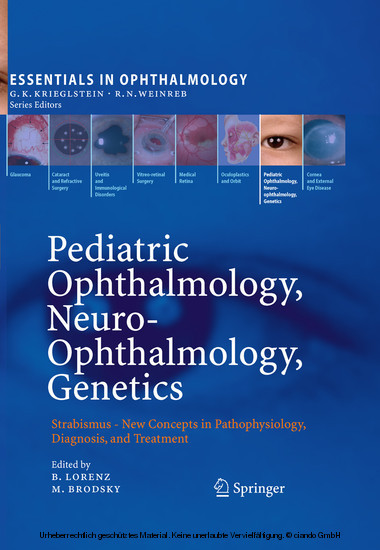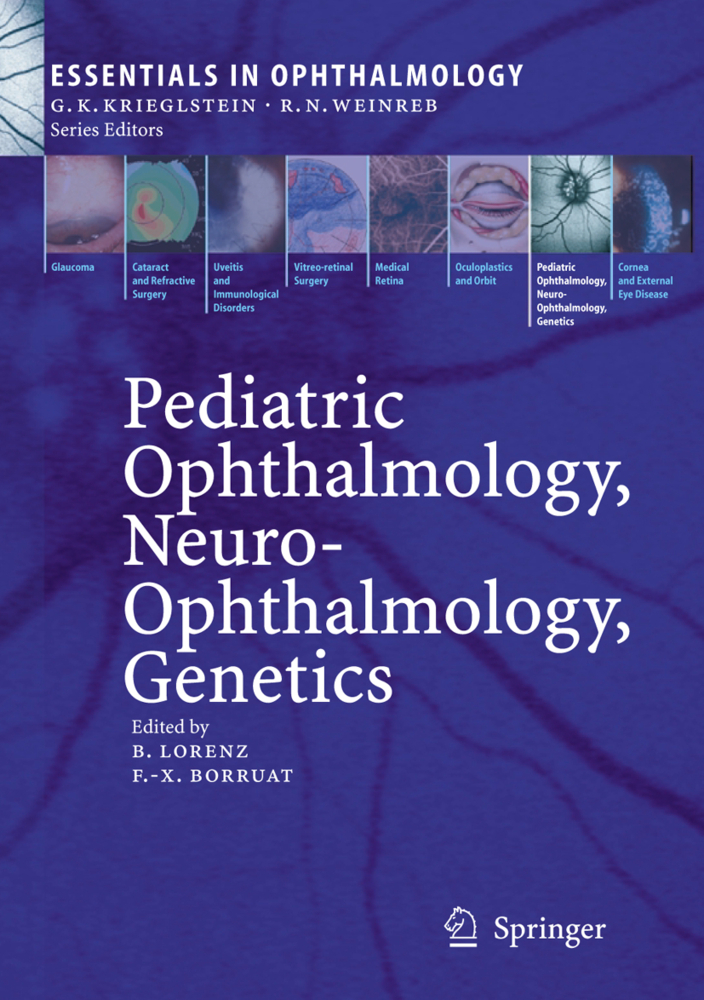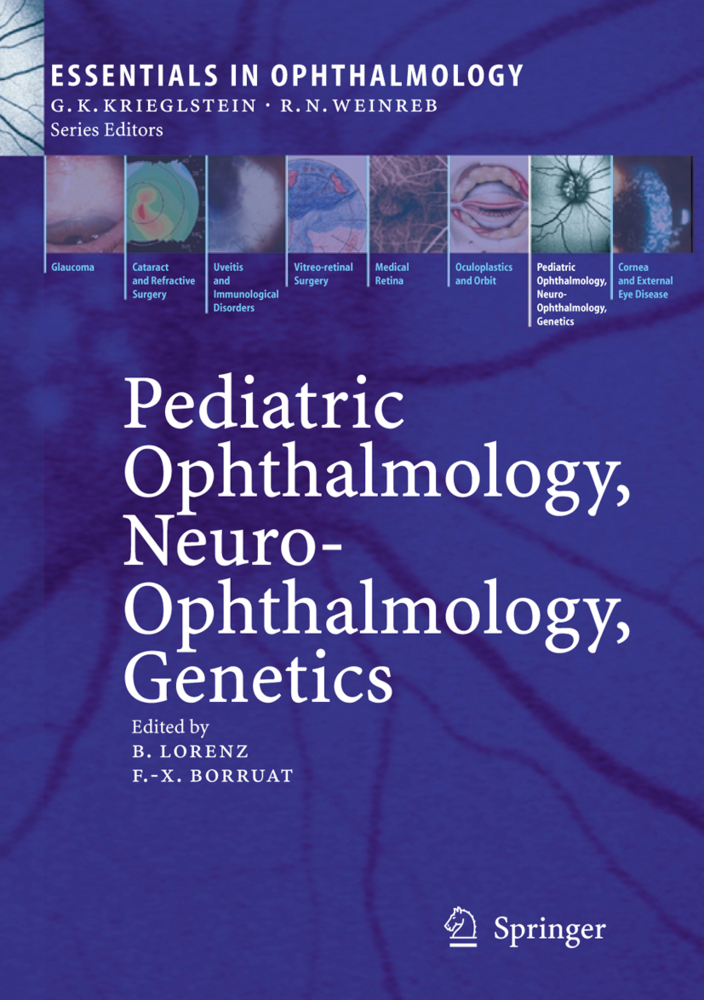Pediatric Ophthalmology, Neuro-Ophthalmology, Genetics
Strabismus - New Concepts in Pathophysiology, Diagnosis, and Treatment
The 8 recurring volumes of the 'Essentials in Ophthalmology' series cover the most recent developments in one of eight subspecialties in Ophthalmology. With four volumes published per year, each subspecialty is newly visited every 24 months, with a distinct focus on recent developments. By bridging the gap between original research and medical textbooks, the transfer of this developing knowledge into daily practice is greatly enhanced.
1;Foreword;6 2;Preface;7 3;Contents;8 4;Contributors;14 5;Chapter 1;16 5.1;Epidemiology of Pediatric Strabismus;16 5.1.1;1.1 Introduction;16 5.1.2;1.2 Forms of Pediatric Strabismus;16 5.1.2.1;1.2.1 Esodeviations;16 5.1.2.1.1;1.2.1.1 Congenital Esotropia;17 5.1.2.1.2;1.2.1.2 Accommodative Esotropia;17 5.1.2.1.3;1.2.1.3 Acquired Nonaccommodative Esotropia;17 5.1.2.1.4;1.2.1.4 Abnormal Central Nervous System Esotropia;17 5.1.2.1.5;1.2.1.5 Sensory Esotropia;17 5.1.2.2;1.2.2 Exodeviations;18 5.1.2.2.1;1.2.2.1 Intermittent Exotropia;18 5.1.2.2.2;1.2.2.2 Congenital Exotropia;18 5.1.2.2.3;1.2.2.3 Convergence Insufficiency;18 5.1.2.2.4;1.2.2.4 Abnormal Central Nervous System Exotropia;18 5.1.2.2.5;1.2.2.5 Sensory Exotropia;18 5.1.2.3;1.2.3 Hyperdeviations;18 5.1.3;1.3 Strabismus and Associated Conditions;19 5.1.4;1.4 Changing Trends in StrabismusEpidemiology;19 5.1.4.1;1.4.1 Changes in Strabismus Prevalence;19 5.1.4.2;1.4.2 Changes in Strabismus Surgery Rates;19 5.1.5;1.5 Worldwide Incidence and Prevalence of Childhood Strabismus;19 5.1.6;1.6 Incidence of Adult Strabismus;22 5.1.7;References;22 6;Chapter 2;25 6.1;Changes in Strabismus Over Time: The Roles of Vergence Tonus and Muscle Length Adaptation1;25 6.1.1;2.1 Binocular Alignment System;25 6.1.1.1;2.1.1 Long-Term Maintenance of Binocular Alignment;25 6.1.1.2;2.1.2 Vergence Adaptation;26 6.1.1.3;2.1.3 Muscle Length Adaptation;26 6.1.2;2.2 Modeling the Binocular Alignment Control System;27 6.1.2.1;2.2.1 Breakdown of the Binocular Alignment Control System;28 6.1.2.2;2.2.2 Clarifi cation of Unanswered Questions Regarding the Long-Term Binocular Alignment Control System;28 6.1.2.3;2.2.3 Changes in Strabismus as a Bilateral Phenomenon;28 6.1.2.4;2.2.4 Changes in Basic Muscle Length;29 6.1.2.5;2.2.5 Version Stimulation and Vergence Stimulation;30 6.1.2.6;2.2.6 Evidence Against the "Final Common Pathway";31 6.1.3;2.3 Changes in Strabismus;32 6.1.3.1;2.3.1 Diagnostic Occlusion: And the Hazard of Prolonged Occlusion;33 6.1.3.2;2.3.2.1 Supporting Evidence for Bilateral Feedback Control of Muscle Lengths;33 6.1.4;2.4 Applications of Bilateral Feedback Control to Clinical Practice and to Future Research;35 6.1.5;References;36 7;Chapter 3;39 7.1;A Dissociated Pathogenesis for Infantile Esotropia;39 7.1.1;3.1 Dissociated Eye Movements;39 7.1.2;3.2 Tonus and its relationship to infantile esotropia;39 7.1.3;3.3 Eaotropia and Exotropia as a Continuum;40 7.1.4;3.4 Distiguishing Esotonus from Convergence;42 7.1.5;3.5 Pathogenetic Role of Dissociated Eye Movements in Infantile Esotropia;43 7.1.6;References;44 8;Chapter 4;46 8.1;The Monofixation Syndrome: New Considerations on Pathophysiology;46 8.2;4.1 Introduction;46 8.3;4.2 Nirmal and Anomalous Binocular Vision;46 8.3.1;4.2.1 Binocular Correspondence: Anomalous, Normal, or Both?;47 8.4;4.3 MFS with Manifest Strabismus;48 8.4.1;4.3.1 Esotropia is the Most Common Form of MFS;48 8.4.2;4.3.2 Esotropia Allows for Better Binocular Vision;48 8.4.3;4.3.3 Esotropia is the Most Stable Form;49 8.5;4.4 Repairing and Producing MFS;49 8.5.1;4.4.1 Animal Models for the Study of MFS;50 8.6;4.5 Primary MFS (Sensory Signs of Infantile-Onset Image Decorrelation);51 8.6.1;4.5.1 Motor Signs of Infantile-Onset Image Decorrelation;51 8.7;References;52 9;Chapter 5;54 9.1;Visual Cortex Mechanisms of Strabismus: Development and Maldevelopment;54 9.1.1;5.1 Esotropia as the Major Type of Developmental Strabismus;54 9.1.1.1;5.1.1 Early-Onset (Infantile) Esotropia;54 9.1.1.2;5.1.2 Early Cerebral Damage as the Major Risk Factor;54 9.1.1.3;5.1.3 Cytotoxic Insults to Cerebral Fibers;55 9.1.1.4;5.1.4 Genetic Infl uences on Formation of Cerebral Connections;55 9.1.1.5;5.1.5 Development of Binocular Visuomotor Behavior in Normal Infants;55 9.1.1.6;5.1.6 Development of Sensorial Fusion and Stereopsis;56 9.1.1.7;5.1.7 Development of Fusional Vergence and an Innate Convergence Bias;57 9.1.1.8;5.1.8 Development of Motion Sensitivity and Conjugate Eye Tracking (Pursuit/OKN);57 9.1.1.9;5.1.
Lorenz, Birgit
Brodsky, Michael C.
| ISBN | 9783540858515 |
|---|---|
| Artikelnummer | 9783540858515 |
| Medientyp | E-Book - PDF |
| Auflage | 2. Aufl. |
| Copyrightjahr | 2010 |
| Verlag | Springer-Verlag |
| Umfang | 232 Seiten |
| Sprache | Englisch |
| Kopierschutz | Digitales Wasserzeichen |







